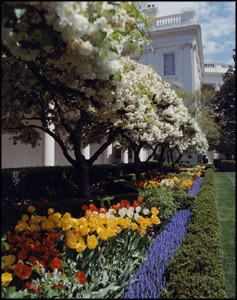- African-American History Month
- Presidents & Baseball
- Grounds and Garden
- Easter Egg Roll
- Christmas & Holidays
- State of the Union
|
Home >
History & Tours >
White House Facts
|
White House Facts
 For two hundred years, the White House has stood as a symbol of
the Presidency, the United States government, and the American people. Its
history, and the history of the nation’s capital, began when President
George Washington signed an Act of Congress in December of 1790 declaring that
the federal government would reside in a district "not exceeding ten miles
square…on the river Potomac." President Washington, together with city
planner Pierre L’Enfant, chose the site for the new residence, which is
now 1600 Pennsylvania Avenue. As preparations began for the new federal city, a
competition was held to find a builder of the "President’s House." Nine
proposals were submitted, and Irish-born architect James Hoban won a gold medal
for his practical and handsome design.
For two hundred years, the White House has stood as a symbol of
the Presidency, the United States government, and the American people. Its
history, and the history of the nation’s capital, began when President
George Washington signed an Act of Congress in December of 1790 declaring that
the federal government would reside in a district "not exceeding ten miles
square…on the river Potomac." President Washington, together with city
planner Pierre L’Enfant, chose the site for the new residence, which is
now 1600 Pennsylvania Avenue. As preparations began for the new federal city, a
competition was held to find a builder of the "President’s House." Nine
proposals were submitted, and Irish-born architect James Hoban won a gold medal
for his practical and handsome design.
Construction began when the first cornerstone was laid in October of 1792. Although President Washington oversaw the construction of the house, he never lived in it. It was not until 1800, when the White House was nearly completed, that its first residents, President John Adams and his wife, Abigail, moved in. Since that time, each President has made his own changes and additions. The White House is, after all, the President’s private home. It is also the only private residence of a head of state that is open to the public, free of charge.
The White House has a unique and fascinating history. It survived a fire at the hands of the British in 1814 (during the war of 1812) and another fire in the West Wing in 1929, while Herbert Hoover was President. Throughout much of Harry S. Truman’s presidency, the interior of the house, with the exception of the third floor, was completely gutted and renovated while the Trumans lived at Blair House, right across Pennsylvania Avenue. Nonetheless, the exterior stone walls are those first put in place when the White House was constructed two centuries ago.
Presidents can express their individual style in how they decorate some parts of the house and in how they receive the public during their stay. Thomas Jefferson held the first Inaugural open house in 1805. Many of those who attended the swearing-in ceremony at the U.S. Capitol simply followed him home, where he greeted them in the Blue Room. President Jefferson also opened the house for public tours, and it has remained open, except during wartime, ever since. In addition, he welcomed visitors to annual receptions on New Year’s Day and on the Fourth of July. In 1829, a horde of 20,000 Inaugural callers forced President Andrew Jackson to flee to the safety of a hotel while, on the lawn, aides filled washtubs with orange juice and whiskey to lure the mob out of the mud-tracked White House.
After Abraham Lincoln’s presidency, Inaugural crowds became far too large for the White House to accommodate them comfortably. However, not until Grover Cleveland’s first presidency did this unsafe practice change. He held a presidential review of the troops from a flag-draped grandstand built in front of the White House. This procession evolved into the official Inaugural parade we know today. Receptions on New Year’s Day and the Fourth of July continued to be held until the early 1930s.
- There are 132 rooms, 35 bathrooms, and 6 levels in the Residence. There are also 412 doors, 147 windows, 28 fireplaces, 8 staircases, and 3 elevators.
- At various times in history, the White House has been known as the "President's Palace," the "President's House," and the "Executive Mansion." President Theodore Roosevelt officially gave the White House its current name in 1901.
- Presidential Firsts while in office... President James Polk (1845-49) was the first President to have his photograph taken... President Theodore Roosevelt (1901-09) was not only the first President to ride in an automobile, but also the first President to travel outside the country when he visited Panama... President Franklin Roosevelt (1933-45) was the first President to ride in an airplane.
- With five full-time chefs, the White House kitchen is able to serve dinner to as many as 140 guests and hors d'oeuvres to more than 1,000.
- The White House requires 570 gallons of paint to cover its outside surface.
- For recreation, the White House has a variety of facilities available to its residents, including a tennis court, jogging track, swimming pool, movie theater, and bowling lane.


